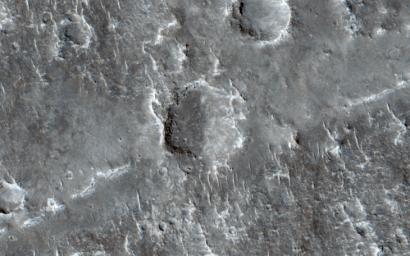
|
A Possible Landing Site for NASA’s InSight Mission
- Click the image above for a larger view
- Full-Res JPEG (2880 x 1800) (1.0 MB)
- Full-Res TIFF (2880 x 1800) (15.6 MB)
Caption:
One of the most difficult aspects of space exploration is finding a safe but scientifically compelling place to land. With HiRISE and its powerful resolution, other mission teams can request HiRISE images of potential future landing sites on Mars.
That's the case with this observation for NASA's upcoming InSight mission, which needs to find a safe, flat landing area that will also meet their mission goals. This area is considered a finalist landing ellipse for the mission, which will delve deep beneath the surface of Mars to search for insight into the processes of terrestrial planet formation.
HiRISE has become an invaluable tool for other Mars missions. We can take hundreds of images of potential landing spots for other science missions, like we did for the successful Phoenix Lander and the rover Curiosity, currently exploring Gale Crater.
Background Info:
HiRISE is one of six instruments on NASA's Mars Reconnaissance Orbiter. The University of Arizona, Tucson, operates the orbiter's HiRISE camera, which was built by Ball Aerospace & Technologies Corp., Boulder, Colo. NASA's Jet Propulsion Laboratory, a division of the California Institute of Technology in Pasadena, manages the Mars Reconnaissance Orbiter Project for the NASA Science Mission Directorate, Washington.
Cataloging Keywords:
| Name | Value | Additional Values |
|---|---|---|
| Target | Mars | |
| System | ||
| Target Type | Planet | |
| Mission | Mars Reconnaissance Orbiter (MRO) | InSight, Mars Science Laboratory (MSL), Phoenix |
| Instrument Host | Mars Reconnaissance Orbiter | Curiosity Rover, InSight Lander, Phoenix Lander |
| Host Type | Orbiter | Lander, Rover |
| Instrument | High Resolution Imaging Science Experiment (HiRISE) | |
| Detector | ||
| Extra Keywords | Color, Crater | |
| Acquisition Date | ||
| Release Date | 2013-05-15 | |
| Date in Caption | ||
| Image Credit | NASA/JPL-Caltech/Univ. of Arizona | |
| Source | photojournal.jpl.nasa.gov/catalog/PIA17729 | |
| Identifier | PIA17729 | |
